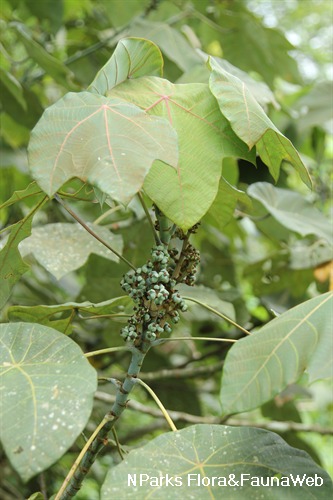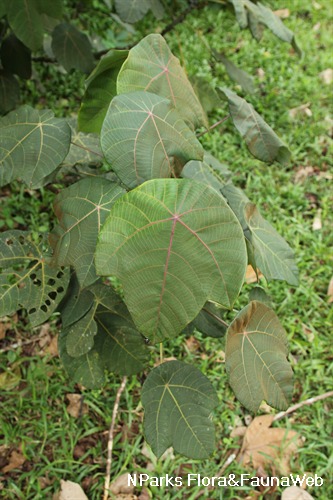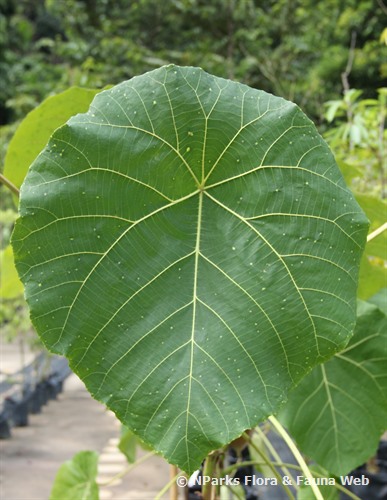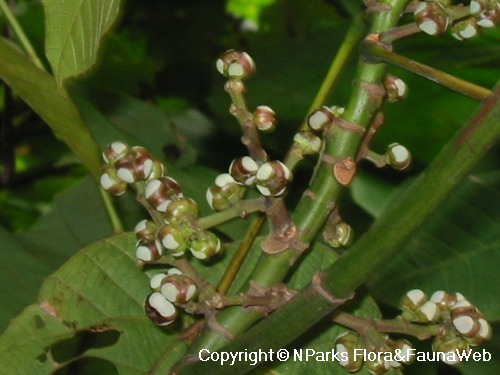
Back
Macaranga griffithiana Müll.Arg.
| Family Name: | Euphorbiaceae |
| Synonyms: | Macaranga motleyana (Müll.Arg.) Whitmore subsp. griffithiana |
| Common Name: | Mahang Bulan, Mahang Tutup |
Name
Classifications and Characteristics
| Plant Division | Angiosperms (Flowering Seed Plants) |
|---|---|
| Plant Growth Form | Tree (Medium (16m-30m)) |
| Lifespan (in Singapore) | Perennial |
| Mode of Nutrition | Autotrophic |
| Plant Shape | Irregular |
| Maximum Height | 20 m |
Biogeography
| Native Distribution | Laos, South Vietnam, Thailand, Peninsular Malaysia, Singapore, and Sumatra |
|---|---|
| Native Habitat | Terrestrial (Primary Rainforest, Secondary Rainforest, Freshwater Swamp Forest) |
| Preferred Climate Zone | Tropical |
| Local Conservation Status | Native to Singapore (Vulnerable (VU)) |
Description and Ethnobotany
| Growth Form | It is a tree that can grow up to 20 m tall, and with hollow twigs. |
|---|---|
| Foliage | Its spirally arranged leaves have pink stalks attached near to the centre of the underside of the leaf blades. Its leaf blades are leathery, egg-shaped, 10–28 by 8–23 cm, shallowly 3- lobed, and whitish with pink veins beneath. |
| Flowers | Its unisexual flowers develop on flowering shoots (inflorescences). Its male inflorescences are 10–25 by 10–18 cm, while female inflorescences are 4–16 by 3–8 cm. |
| Fruit | Its fruits are bluish capsules that are somewhat round, 7–9 by 6–12 mm, covered with yellowish powder, and each consist of 4–5 compartments. Its seeds are black, somewhat triangular-egg-shaped, 3.5–4 mm across, and each encased in a red covering (aril). |
| Habitat | It grows in lowland swampy areas, and is common in swampy secondary forests. It occurs locally in Nee Soon Swamp Forest, Pulau Tekong, Pulau Ubin, Western Catchment, and along Old Upper Thomson Road. |
| Associated Fauna | Ants can inhabit in its hollow twigs. |
| Cultivation | It can be propagated by seed. |
| Etymology | Macaranga may be derived from a local name in Madagascar, or from Sanskrit words that mean body of monkey; Latin griffithiana, commemorates William Griffith (1810–1845), a British botanist and medical doctor |
| Ethnobotanical Uses | Cultural / Religious: In
Pahang, Malaysia, its leaves have been recorded to be used in occult practices for
washing the face of a delirious man. Others: It is occasionally cultivated as an ornamental tree. |
Landscaping Features
| Landscaping | This species is cultivated as an ornamental tree for its attractive foliage, and may be tolerant of park or roadside conditions. Based on its natural habitats, it appears to be tolerant of wet to moderately wet soil conditions. |
|---|---|
| Desirable Plant Features | Ornamental Foliage, Ornamental Fruits |
| Landscape Uses | General, Suitable for Roadsides, Parks & Gardens, Small Gardens, Riverine, Pond / Lake / River, Marsh / Bog |
| Thematic Landscaping | Naturalistic Garden |
Fauna, Pollination and Dispersal
| Pollination Method(s) | Biotic (Fauna) |
|---|---|
| Seed or Spore Dispersal | Biotic (Fauna) |
Plant Care and Propagation
| Light Preference | Full Sun, Semi-Shade |
|---|---|
| Water Preference | Lots of Water, Moderate Water |
| Plant Growth Rate | Moderate |
| Rootzone Tolerance | Moist Soils, Fertile Loamy Soils |
| Propagation Method | Seed |
Foliar
| Foliage Retention | Evergreen |
|---|---|
| Mature Foliage Colour(s) | Green, Green - Bluish Green |
| Mature Foliage Texture(s) | Leathery |
| Prominent Young Flush Colour(s) | Green |
| Foliar Type | Simple / Unifoliate |
| Foliar Arrangement Along Stem | Alternate |
| Foliar Attachment to Stem | Petiolate |
| Foliar Shape(s) | Non-Palm Foliage (Palmate) |
| Foliar Venation | Pinnate / Net |
| Foliar Margin | Entire |
| Foliar Base | Rounded / Obtuse |
Floral (Angiosperm)
| Flower & Plant Sexuality | Unisexual Flowers |
| Flower Grouping | Cluster / Inflorescence |
|---|
Fruit, Seed and Spore
| Mature Fruit Colour(s) | Blue, Yellow / Golden |
|---|---|
| Mature Fruit Texture(s) | Powdery / Waxy Bloom |
| Fruit Classification | Simple Fruit |
| Fruit Type |
Image Repository
Others
| Master ID | 31303 |
|---|---|
| Species ID | 5700 |
| Flora Disclaimer | The information in this website has been compiled from reliable sources, such as reference works on medicinal plants. It is not a substitute for medical advice or treatment and NParks does not purport to provide any medical advice. Readers should always consult his/her physician before using or consuming a plant for medicinal purposes. |




.jpg)

